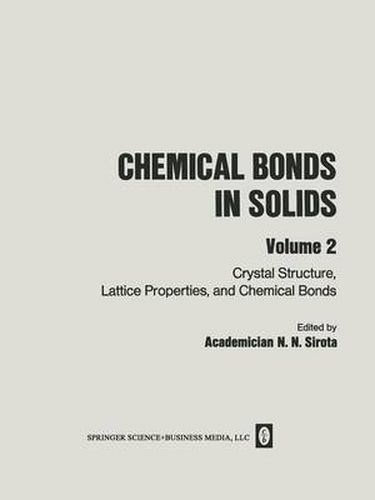Readings Newsletter
Become a Readings Member to make your shopping experience even easier.
Sign in or sign up for free!
You’re not far away from qualifying for FREE standard shipping within Australia
You’ve qualified for FREE standard shipping within Australia
The cart is loading…






This title is printed to order. This book may have been self-published. If so, we cannot guarantee the quality of the content. In the main most books will have gone through the editing process however some may not. We therefore suggest that you be aware of this before ordering this book. If in doubt check either the author or publisher’s details as we are unable to accept any returns unless they are faulty. Please contact us if you have any questions.
The present four volumes, published under the collective title of Chemical Bonds in Solids, are the translation of the two Russian books Chemical Bonds in Crystals and Chemical Bonds in Semiconductors. These contain the papers presented at the Conference on Chemical Bonds held in Minsk between May 28 and June 3, 1967, together with a few other papers (denoted by an asterisk) which have been specially incorporated. Earlier collections (also published by the Nauka i Tekhnika Press of the Belorussian Academy of Sciences) were entitled Chemical Bonds in Semiconductors and Solids (1965) and Chemical Bonds in Semiconductors and Thermody namics (1966) and are available in English editions from Consultants Bureau, New York (pub lished in 1967 and 1968, respectively). The subject of chemical bonds in crystals, including semiconductors, has recently become highly topical and has attracted the interest of a wide circle of physicists, chemists, and engineers. Until recently, the most successful description of the properties of solids (including semi conductors) has been provided by the band theory, which still dominates the physics of solids. Nevertheless, it is clear that the most universal approach is that based on the general theory of chemical bonds in crystals, in which details of the electron distributions between atoms and of the wave functions appear quite expliCitly.
$9.00 standard shipping within Australia
FREE standard shipping within Australia for orders over $100.00
Express & International shipping calculated at checkout
This title is printed to order. This book may have been self-published. If so, we cannot guarantee the quality of the content. In the main most books will have gone through the editing process however some may not. We therefore suggest that you be aware of this before ordering this book. If in doubt check either the author or publisher’s details as we are unable to accept any returns unless they are faulty. Please contact us if you have any questions.
The present four volumes, published under the collective title of Chemical Bonds in Solids, are the translation of the two Russian books Chemical Bonds in Crystals and Chemical Bonds in Semiconductors. These contain the papers presented at the Conference on Chemical Bonds held in Minsk between May 28 and June 3, 1967, together with a few other papers (denoted by an asterisk) which have been specially incorporated. Earlier collections (also published by the Nauka i Tekhnika Press of the Belorussian Academy of Sciences) were entitled Chemical Bonds in Semiconductors and Solids (1965) and Chemical Bonds in Semiconductors and Thermody namics (1966) and are available in English editions from Consultants Bureau, New York (pub lished in 1967 and 1968, respectively). The subject of chemical bonds in crystals, including semiconductors, has recently become highly topical and has attracted the interest of a wide circle of physicists, chemists, and engineers. Until recently, the most successful description of the properties of solids (including semi conductors) has been provided by the band theory, which still dominates the physics of solids. Nevertheless, it is clear that the most universal approach is that based on the general theory of chemical bonds in crystals, in which details of the electron distributions between atoms and of the wave functions appear quite expliCitly.